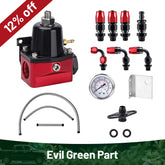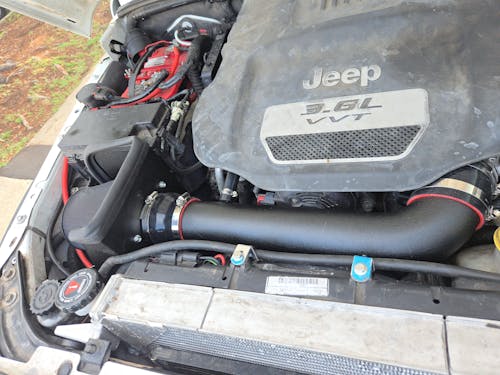-
EVIL ENERGY Fuel Pressure Regulator 6AN EFI Bypass Return Adjustable 20-140psi Black&Red - Red
- $75.99
- $75.99
$119.99- Unit price
- per
-
Red
-
Black
-
EVIL ENERGY CPE/PTFE LS Swap fuel kit ,Fuel Filter, 6AN Fuel Line & Fittings | 20-120PSI Fuel Pressure Regulator | Fuel Pump
- $279.99
- $279.99
$390.99- Unit price
- per
-
EVIL ENERGY Full LS Swap EFI Fuel Setup with 300LPH Electric Fuel Pump, 20-120PSI Regulator, 6AN 20FT Fuel Hose and Filter
- $309.99
- $309.99
$397.99- Unit price
- per
-
Evil Energy LS Swap Fuel System Kit | 6AN Adjustable Fuel Pressure Regulator with PTFE Fuel Line 25FT - Black
- $189.98
- $189.98
$223.98- Unit price
- per
-
Black
-
Silver
-
EVIL ENERGY 6AN Fuel System Kit with 300LPH Pump & Adjustable Regulator - Universal LS Engine Upgrade
- $303.99
- $303.99
$389.99- Unit price
- per
-
EVIL ENERGY PTFE LS Swap Fuel Kit | Fuel Filter 10 Micron With Fuel Pressure Regulator 20-140PSI | 6AN 20FT Fuel Line
- $245.99
- $245.99
- Unit price
- per
-
EVIL ENERGY EFI Returnless Fuel System Kit Fuel Pressure Regulator Adjustable 20-120PSI | 8 Installation Combo
- $129.99
- $129.99
$135.19- Unit price
- per
-
EVIL ENERGY EFI Returnless Fuel System kit-Fuel Cell Gas Tank Fuel Filter with Fuel Pressure Regulator Adjustable
- $34.59
- $34.59
$166.98- Unit price
- per
-
EVIL ENERGY EFI Returnless Fuel System Kit Fuel Pressure Regulator Adjustable 20-120PSI | 10 micron fuel filter
- $149.99
- $149.99
$128.79- Unit price
- per
-
EVIL ENERGY 10Gal Fuel Cell Kit - 300LPH Pump, CPE Lines & AN Fittings
- $649.99
- $649.99
$765.99- Unit price
- per
-
EVIL ENERGY Eco-Friendly Fuel Pressure Regulator 6AN EFI Bypass Return Adjustable 30-70psi Black&Red
- $75.99
- $75.99
$119.99- Unit price
- per
-
Evil Energy LS EFI System - Master Kit | Intake Manifold & Fuel Rail for Gen III LS1, LS2 | Inline Fuel Pump | Fuel Filter | PTFE Fuel Hose
- $826.68
- $826.68
$972.97- Unit price
- per
-
Evil Energy LS EFI System - Master Kit | Intake Manifold & Fuel Rail for GM LS3 L92 V8 6.2L | Inline Fuel Pump | Fuel Filter | PTFE Fuel Hose
- $648.18
- $648.18
$762.59- Unit price
- per
-
Evil Energy LS EFI System - Master Kit | Intake Manifold & Fuel Rail for GM LS1/LS2/LS6 | Inline Fuel Pump | Fuel Filter | PTFE Fuel Hose
- $622.59
- $622.59
$732.89- Unit price
- per
-
EVIL ENERGY 0928400535 Diesel Fuel Pressure Regulator Compatible with 2001-2004 6.6L LB7 Duramax DieselThe Diesel Fuel Pressure Regulator for the 2001-2004 LB7 Duramax Diesel engine is a high-performance component designed to ensure precise fuel pressure control, optimizing your engine's fuel system for maximum efficiency and reliability. This part is specifically engineered for the LB7 Duramax, offering a...
- $29.99
- $29.99
$29.99- Unit price
- per
-
EVIL ENERGY 0928400666 Diesel Fuel Pressure Regulator Compatible with Dodge Ram Cummins 2003-2007 Diesel 5.9LAbout this item Replace OE Part Number: 0928400666, 4932457, 5183245AA. Inlet Port Diameter:0.12 in. Please check the OE number before purchasing, make sure this is the right part you need Fitment/Compatibility: compatible with 2003-2007 5.9L Dodge Ram Cummins Diesel Function: A adjustable fuel pressure...
- $29.99
- $29.99
$29.99- Unit price
- per
Get an Exclusive 8% Off Your First Purchase
Subscribe now to get a gift with your first order!






![[CPE]](http://www.ievilenergy.com/cdn/shop/files/EVIL-ENERGY-Fuel-Cell-Tank-Kit-Efficient-Fuel-System-Solutions-5-10-15-Gallon-EVIL-ENERGY-141125253_165x.jpg?v=1763743749)
![[PTFE]](http://www.ievilenergy.com/cdn/shop/files/EVIL-ENERGY-Fuel-Cell-Tank-Kit-Efficient-Fuel-System-Solutions-5-10-15-Gallon-EVIL-ENERGY-141125361_165x.jpg?v=1763743749)
![[30-70PSI]](http://www.ievilenergy.com/cdn/shop/files/EVIL-ENERGY-Eco-Friendly-Fuel-Pressure-Regulator-6AN-EFI-Bypass-Return-Adjustable-30-70psi-Black_Red-EVIL-ENERGY-151921892_165x.png?v=1763746180)
![[30-70PSI,Black]](http://www.ievilenergy.com/cdn/shop/files/01_48_165x.png?v=1760696967)
![[Fuel Pump Kit]](http://www.ievilenergy.com/cdn/shop/files/1_EVKT0202451_PTFE_Hose_Kit_165x.jpg?v=1751867620)
![[Fuel Filter Regulator Kit]](http://www.ievilenergy.com/cdn/shop/files/1_EVKT0202451_Fuel_Filter_Regulator_Kit_165x.webp?v=1751867620)
![[CPE]](http://www.ievilenergy.com/cdn/shop/files/EVIL-ENERGY-CPE-PTFE-LS-Swap-fuel-kit-_Fuel-Filter_-6AN-Fuel-Line-_-Fittings-_-20-120PSI-Fuel-Pressure-Regulator-_Inline-Fuel-Pump-EVIL-ENERGY-141129965_165x.jpg?v=1763743806)
![[PTFE]](http://www.ievilenergy.com/cdn/shop/files/EVIL-ENERGY-CPE-PTFE-LS-Swap-fuel-kit-_Fuel-Filter_-6AN-Fuel-Line-_-Fittings-_-20-120PSI-Fuel-Pressure-Regulator-_Inline-Fuel-Pump-EVIL-ENERGY-141130074_165x.jpg?v=1763743806)
![[CPE]](http://www.ievilenergy.com/cdn/shop/files/EVIL-ENERGY-LS-Swap-Fuel-Kit-_-Fuel-Filter_6AN-20FT-Fuel-Hose-_20-120PSI-Regulator-_-300LPH-High-Flow-Fuel-Pump-For-LS-Swap-EFI-Systems-and-More-_Copy_-EVIL-ENERGY-139826211_165x.jpg?v=1763743548)
![[PTFE]](http://www.ievilenergy.com/cdn/shop/files/EVIL-ENERGY-LS-Swap-Fuel-Kit-_-Fuel-Filter_6AN-20FT-Fuel-Hose-_20-120PSI-Regulator-_-300LPH-High-Flow-Fuel-Pump-For-LS-Swap-EFI-Systems-and-More-_Copy_-EVIL-ENERGY-139826366_165x.jpg?v=1763743552)
![[30-70PSI,Black]](http://www.ievilenergy.com/cdn/shop/files/6a0f48436f03bf48e8c7f28f9f150b4c_9032cb8a-7326-4af8-b764-a0d0e73e888f_165x.png?v=1736932194)
![[20-75PSI&75-120PSI,Black]](http://www.ievilenergy.com/cdn/shop/files/1_c2204516-17cc-492b-a861-90804afd12df_165x.png?v=1753692436)
![[PTFE]](http://www.ievilenergy.com/cdn/shop/files/1_EVKT0202431_PTFE_165x.webp?v=1751867724)
![[CPE]](http://www.ievilenergy.com/cdn/shop/files/1_EVKT0202431_CPE_165x.webp?v=1751867724)
![[28PCS]](http://www.ievilenergy.com/cdn/shop/files/EVKT0202408_b4279f6e-23b7-4942-89bd-364ff4bc8b6e_165x.jpg?v=1735213943)
![[29PCS]](http://www.ievilenergy.com/cdn/shop/files/EVKT0202407_3_165x.jpg?v=1735213945)
![[7PCS(20-120PSI)]](http://www.ievilenergy.com/cdn/shop/files/EVKT0202403_165x.jpg?v=1735211912)
![[6PCS(20-120PSI)]](http://www.ievilenergy.com/cdn/shop/files/EVKT0202404_165x.jpg?v=1735211914)
![[5 Gallon,30-70PSI,10 Mircon] EVIL ENERGY Fuel Cell Kit with regulator, inline pump, AN fittings, and installation accessories - high-performance fuel cell solution for EFI systems](http://www.ievilenergy.com/cdn/shop/files/first_165x.jpg?v=1753689299)
![[Without Fuel Filter,Without Fuel Pressure Regulator] EVIL ENERGY aluminum fuel cell tank – black high-capacity racing fuel cell for automotive performance applications](http://www.ievilenergy.com/cdn/shop/files/Black_and_White_Illustrated_Car_Parts_Retail_Instagram_Post_165x.png?v=1753689299)
![[With Quick-Release Connector]](http://www.ievilenergy.com/cdn/shop/files/EFI-Returnless-Fuel-System-Kit-Fuel-Pressure-Regulator-Adjustable-20-120PSI-_-10-micron-fuel-filter_-EVIL-ENERGY-EVILENERGY-105518979_165x.jpg?v=1735213640)
![[Without Quick-Release Connector]](http://www.ievilenergy.com/cdn/shop/files/2-1_1924f28b-aa94-483a-a8ea-cd25e9af933d_165x.webp?v=1735213641)
![[CPE Vacuum Hose Fit] EVIL ENERGY 10-gallon fuel cell kit with aluminum fuel tank, fuel hoses, AN fittings, fuel filter, pressure gauge, and complete installation accessories, free shipping and 180-day return](http://www.ievilenergy.com/cdn/shop/files/EVKT0202440__1.0_165x.jpg?v=1735213861)
![[CPE Fuel Hose Fit] EVIL ENERGY 10-gallon fuel cell kit with aluminum fuel tank, fuel hoses, AN fittings, fuel filter, pressure gauge, and complete installation accessories, free shipping and 180-day return](http://www.ievilenergy.com/cdn/shop/files/EVKT0202441_fba4e659-81da-409c-a367-7657ef0c437d_165x.jpg?v=1735213862)

![[30-70PSI]](http://www.ievilenergy.com/cdn/shop/files/ptfe_fuel_line_fitting_165x.png?v=1748411507)
![[20-75PSI&75-120PSI] fuel filter](http://www.ievilenergy.com/cdn/shop/files/evil_energy_fuel_filter_165x.png?v=1748411507)
























